Category Archive for Mexico + Central America
Why are Mexican cemeteries so colorful? Rainbow tombstones, Day of the Dead rituals & skeleton art in Yucatan!
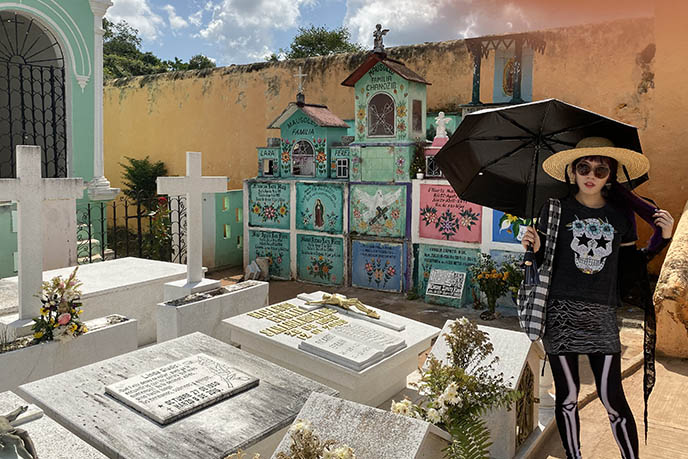
It’s hard to feel “grave” in this Mexican graveyard… Even my skull shirt is smiling!
Let’s welcome 2020 with more Day of the Dead stories from Mexico.
Last November, I joined a trip led by Borderline Projects x Morbid Anatomy (you can already get on the email list for next year’s tour). We traveled through the Yucatan, and learned how this joyful ritual celebrates departed friends and family.
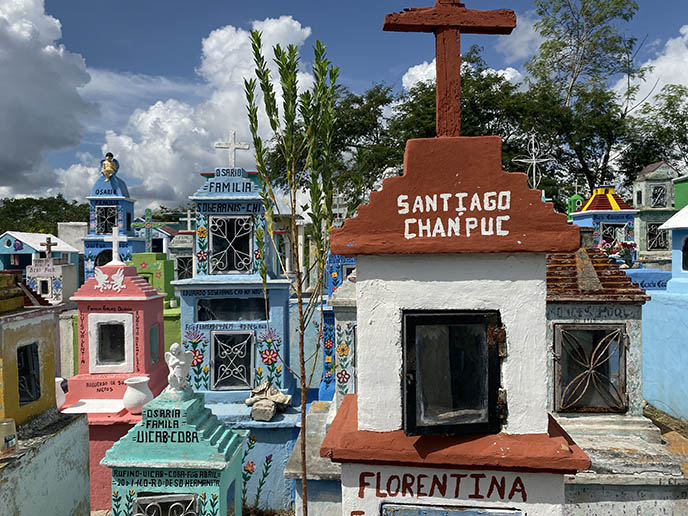
On the first evening, I celebrated Dia de los Muertos with a Lost Souls parade in a Merida cemetery (see this story).
On day 2, Borderline Projects took us to colorful graveyards in Hoctun and Izamal, where we witnessed families cleaning the rainbow tombs and making loving offerings.

Even though it was November 1st, the Yucatan was still very hot and humid. (Hello, global warming…)
I’m wearing oversized designer sunglasses by Balenciaga, and a sugar skull screenprinted t-shirt by Chaser Brand.
I’m hiding from UV rays under four types of mineral sunscreen, a Goth skull umbrella by Raven Goods, and a wide-brimmed hat by Lack of Color. More from these designers below:
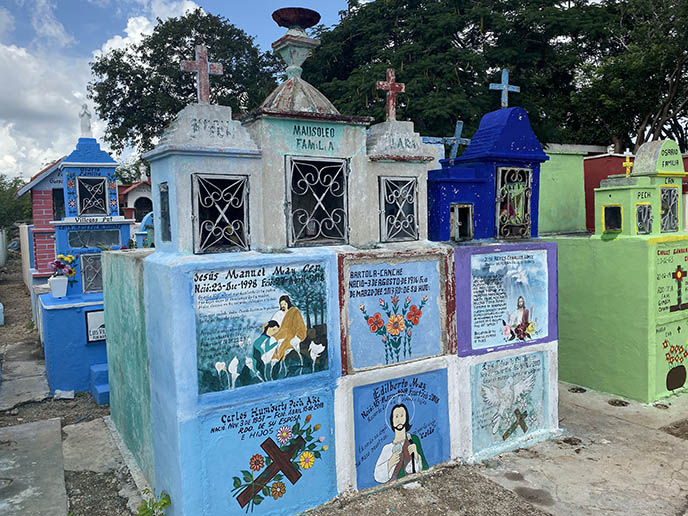
Borderline’s “Death in Mexico” tour arranged all our hotels and transportation for four days. Our group of about 40 people drove 45 km east from Mérida, and soon arrived in Hoctun — one of over 100 municipalities in the Yucatan.
While many Mexican burial grounds are colorful, Cemetario Hoctun stands out as one of the most eccentric and vivid. Talented artists in the community painted flowers and religious images on the house-like tombs.
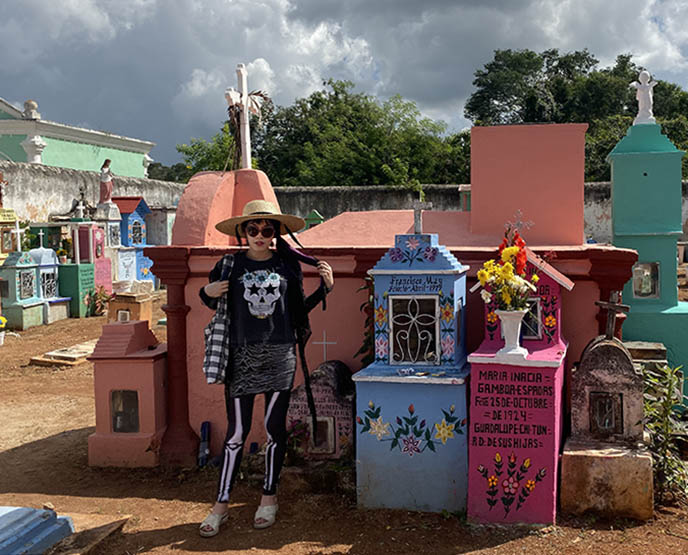
Day of the Dead actually spreads out over several days, and each region of Mexico has its own cultural twist on the tradition.
In the Yucatan, November 1st is “U Hanal Nucuch Uinicoob,” or dedicated to the adults who have left this world. They are remembered with offerings of food, alcohol, cigarettes and other favorites placed on their graves, and/or in altars set up in homes.
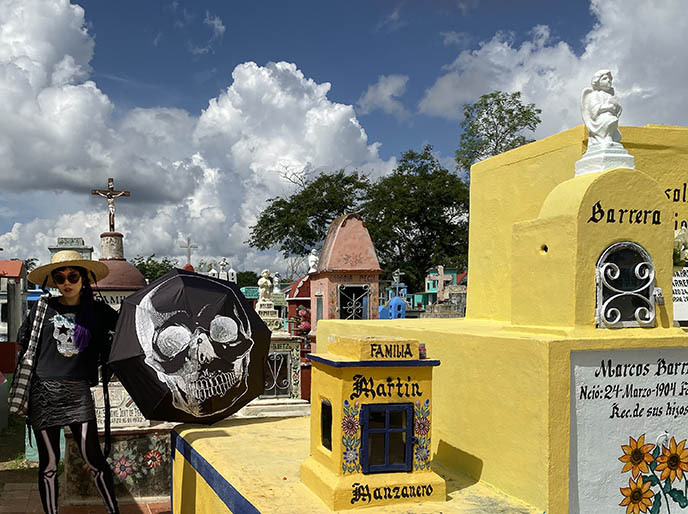
I loved strolling through Hoctun Cemetery, and seeing the wide, creative variety of tombs. Families painted these resting places with the favorite color of the deceased, and added artistic or sculptural flourishes that represented them.
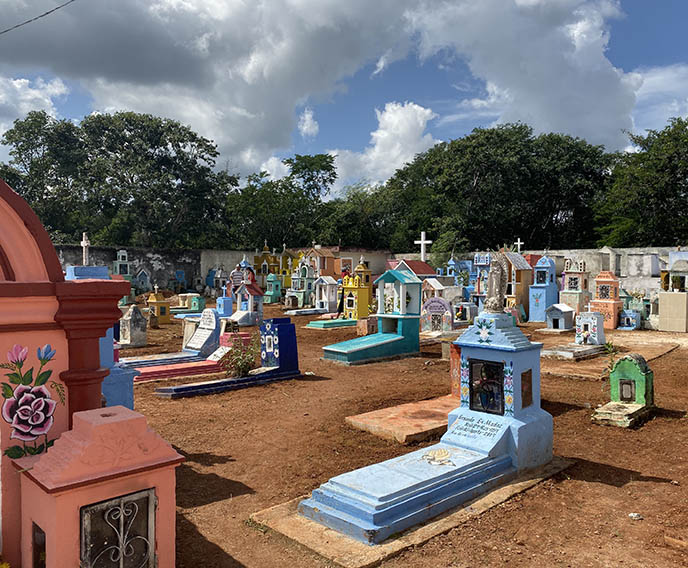
We tend to think of graveyards as “spooky, gloomy, haunted” places — but that’s not the case in Mexico. I can’t imagine a zombie or vampire living in one of these pastel rainbow tombs!
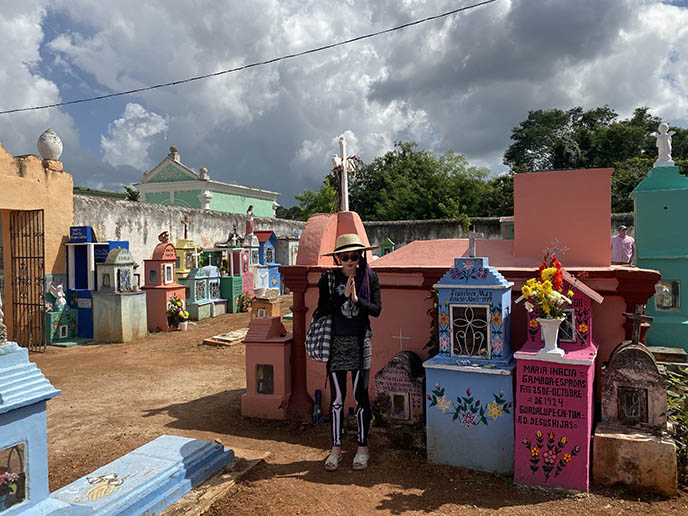
The brightly colored mausoleums convey the Day of the Dead attitude to the end of life. There’s no real separation between the living and dead, and we should celebrate them with glee.

Hoctun’s graves are well-tended and decorated. Family members keep the colors vivid with fresh coats of paint, especially around this time of year.

Most bear the typical markers of Christianity (crosses, angels) — but others are unique expressions of Mayan culture.
Some of the graves look like traditional houses, with circular forms. Others are painted with marigold flowers, or huipil embroidered clothing patterns. On my right, you can see a roof shaped like an ancient Maya pyramid!

In addition to Dia de Muertos-related activities, Borderline Projects’ tour lets you dig deep into the local culture, architecture, crafts and food.
Our bus continued to Izamal, and stopped at the foot of Kinich Kakmó. This partly-restored Mayan pyramid is the third largest in the Yucatán, rising 34 meter high.
(I’m wearing a Gothic parasol by Raven Goods, a skeleton shirt by Chaser, and a sun hat by Lack of Color.)
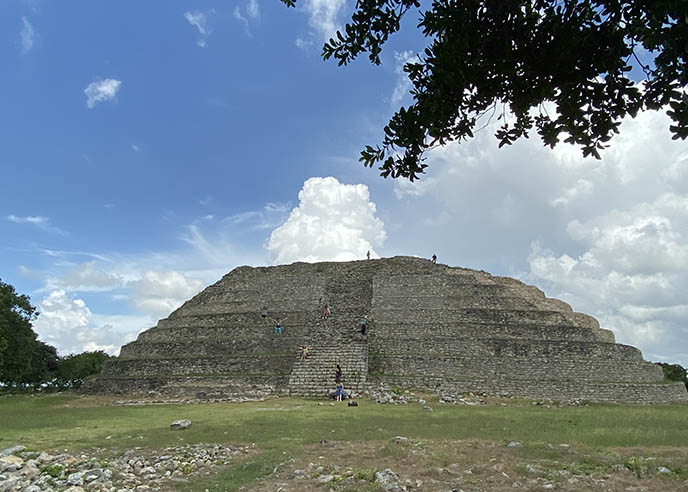
Made out of limestone, this Mayan pyramid is dedicated to the deity Kinich Kakmó, or “the fire macaw with the sun face.” Fittingly for this sunny region, he is a solar god.

First, you have to climb up these stone steps to reach the grassy plain where the pyramid stands. From there, you can choose to scramble up the steep incline.
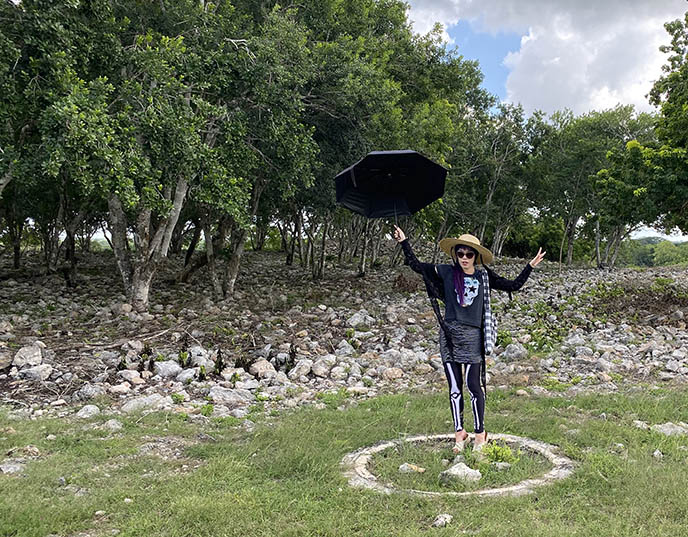
Mayan civilization was remarkably advanced, and full of mysteries that we’ve yet to understand.
Why is there a ring near the foot of Kinich Kakmo? A crop circle of the apocalypse… or a portal into an alternate universe?

In ancient times, people would present sacrificial offerings to Kinich Kakmó under the scorching sun that he represented. Some say the deity would take on the form of a fiery macaw, and fly down to grab the sacrifices.

The pyramid dates back to the Mayan classic era, or 400-600 ACE. The immensity of the stones reminded me of the pyramids of Giza, Egypt.

The Yucatan and Riviera Maya have plenty of famous pyramids, such as Coba and Chichen Itza (see my guide to these ruins).
Personally, I prefer exploring the lesser-known but just-as-impressive structures like this one. Entry is free, and you can avoid seeing tourists everywhere.

Borderline’s Mexico cultural tour included plenty of free time, which is great for travellers (especially seasoned ones) who prefer a less structured experience.
Photographer Julie Hunter and I wandered around the small town of Izamal, which is as multicolored as the graveyard. These men are hanging out by a Paleteria for popsicles and frozen ice cream treats.

This churros almost had my name on it! (I skipped the street food, just to be careful. Read on to see where I feasted.)
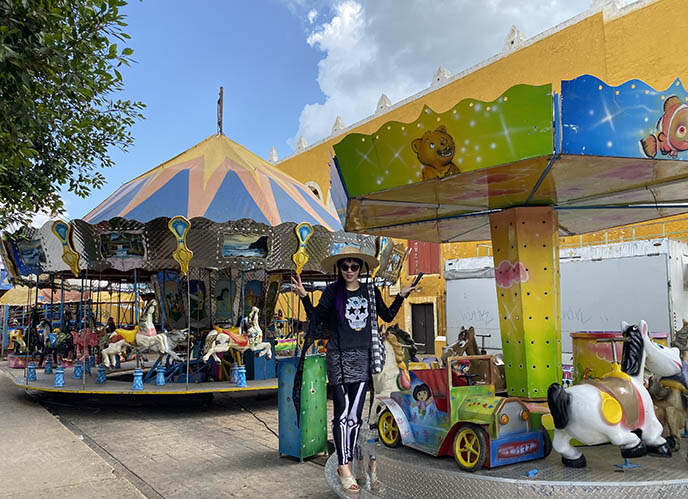
At home with the kitsch of a Mexican carnival. The merry-go-round had a Roadrunner and Pikachu, in addition to horses.

I had never heard of Izamal before this tour. Most tourists stick to Mexican resorts, so I’m glad I got to see off-the-beaten-path places like this.
Known as the “yellow city,” Izamal is one of Mexico’s “17 Magical Towns” (Pueblos Mágicos) thanks to its charming architecture, and mystical background.

Izamal was once a Mayan spiritual center with multiple pyramids. After the Spanish came, locals were forced to tear down the main pyramid and build this monastery and church on top. The conquistadors believed this would dissuade residents from “devil worship.”

However, miracles of healing began to occur. The Mayans had previously dedicated their pyramid to Itzam Na, a god of healing… perhaps the “devil” prevailed after all? (Even though this red crucifix isn’t upside-down!)

One of my goals in visiting the Yucatán was to try as many local dishes as possible. Here, Day of the Dead is known as Hanal Pixan, or Food of the Souls.
This restaurant shows the type of altar that people set up in the homes. Photos of deceased ancestors are lovingly displayed next to marigold flowers, fruits, drinks, and food offerings.
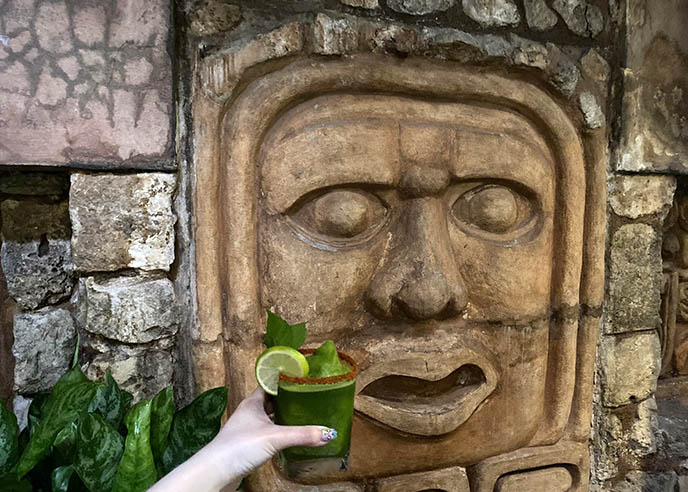
Our group had lunch at Kinich, known as the best restaurant in Izamal.
I discovered my new favorite drink — chaya. It’s a refreshing vegetable juice made from tree spinach, a shrub native to the Yucatan. Full of nutrients, this green drink is especially tasty as a margarita with tequila and a salted rim. (I simply had to offer this Mayan big-head a sip!)

Julie and I shared a sampling at Kinich. These are handmade tortillas in different styles (salbutes and panuchos), with roast chicken and avocado, cochinita pibil (marinated pulled pork shoulder), and relleno negro (more on that below).
On another day, I tried mucbil pollo, or “chicken that has been buried” — it’s the special dish eaten for Day of the Dead in the Yucatan. Mucbipollo is similar to a tamale, but larger and crunchier. Usually filled with chicken and pork, it’s wrapped in banana leaves and slow-cooked underground. Hearty and multi-faceted — we loved it.

In Kinich’s restaurant garden, you can smell and touch some of the regional ingredients used in the dishes. Our guide Claudia is showing us achiote, an orange-red tree seed that adds a nutty, peppery flavor.
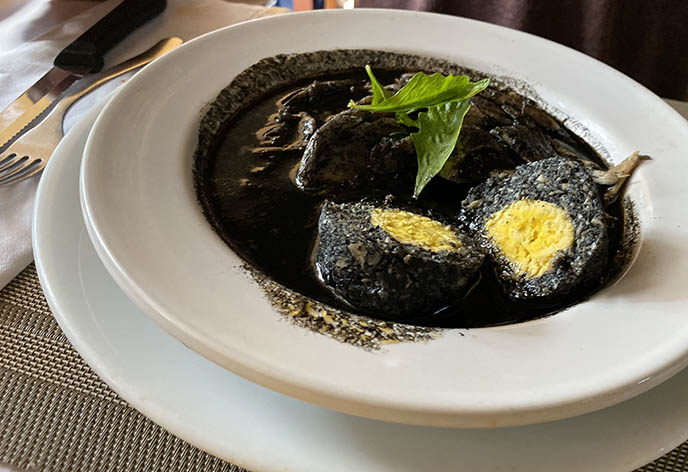
Achiote is one of the many ingredients in relleno negro, a Yucatecan dish with a rather Gothic look! It consists of chicken and a hard boiled egg in a savory black sauce: the dark result of mixing various chili peppers and seasonings.
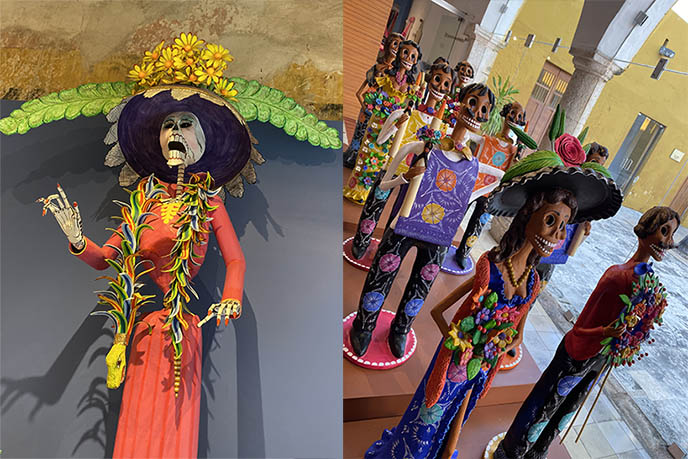
Before leaving Izamal, we popped into the Centro Cultural y Artesanal. This small art and cultural center holds an inspiring collection of Mexican folk art, made from all types of media.
Entrance costs 25 pesos (just over $1 US), and it’s worth it to see the many happy skeletons inside. A tall La Catrina towers over one room, with a snake draped around her neck. (Is she signing opera? And how fabulous are her nails?)

Special delivery from a devil, skeleton and angel… Bread of the Dead, carried on the head! (Did you notice they are biking on top of colored skulls?)

On the right, these cute skeletons are dancing the Mexican maypole / ribbon dance, El Baile de las Cintas.
On the left, the fight between good and evil never ends… (Will the devil flip over the angel, and turn the cross upside down?)

I enjoyed discovering Mexican artists like Gabriel Pérez Rajón. The jaguar is an important symbol for the Mayans, and he gives the fierce felines a modern, cute interpretation.

My eyes were drawn to this ceramic funeral procession by Alfonso Soteno. Lots of sugar skulls, jaguars and warriors joined the happy parade.

Izamal’s artisan museum lets you see lively works from communities all around the country. You can also purchase home goods or fashion items to support these rural creators (I was tempted by an embroidered skull tote bag.)

As the sun was setting, our tour arrived at Izamal municipal cemetery. Just like in Hoctun, this Cementerio Municipal is a colorful resting ground filled with personality.
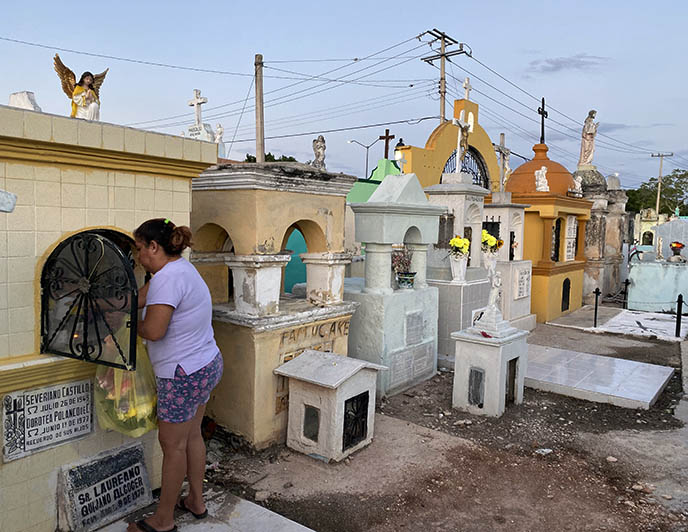
How wonderful to see people bringing food and flowers for their loved ones to enjoy.

Hanal Pixan’s rituals keeps the connection strong between the living and the dead.

Many families come here together to place ofrenda, and remember the dead through stories.

Izamal’s cemetery is arranged a tad haphazardly, but that adds to the quirky, individual feeling of the grave markers.

Many of the “houses” had a vivid fresh coat of paint. This lady is opening up the door to put flowers inside.
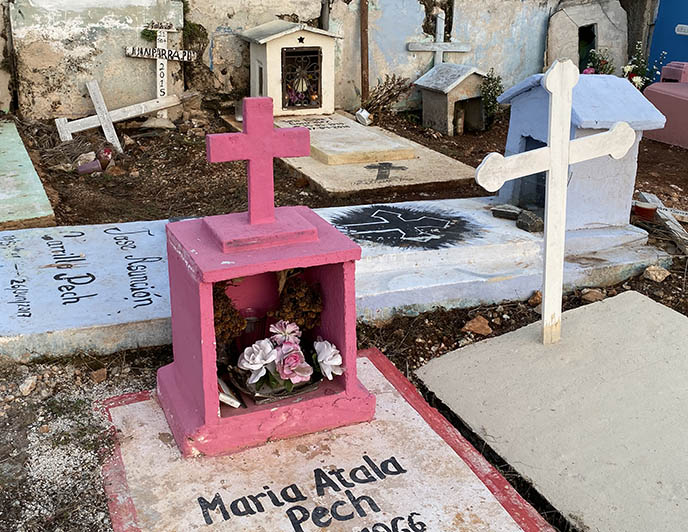
This photo made me think of a quote: “From my rotting body, flowers shall grow, and I am in them, and that is eternity.” — Edvard Munch

It was a joy to explore Yucatan’s cemeteries, with a group of intelligent and darkly-inclined travellers.

A Gothic gown is perfect for walking through the aisles of the dead.

Never forget, we all have one foot in the grave… Might as well have fun while we’re still on this Earth.

Coming up, I’ll show you the ossuaries and poignant “brushing of the bones” ritual that we witnessed on Day 3.

Isn’t it remarkable how much we did in a single day? And the night’s not over yet…. Borderline Projects suggested that we visit Cathedral of Mérida at night, for a special sporting event.

I was thrilled to see a demonstration of Pok-A-Tok, the ancient Mayan ball game! I took this photo of the fierce drummer and dancer, who look like living skeletons.

The musicians and dancers set the stage with a performance inspired by Mayan legends. A man dressed as an owl leapt and flapped his wings, referencing the owls that invited brothers Hun-Hunahpú and Vucub Hunahpú to play the deadly ball game.
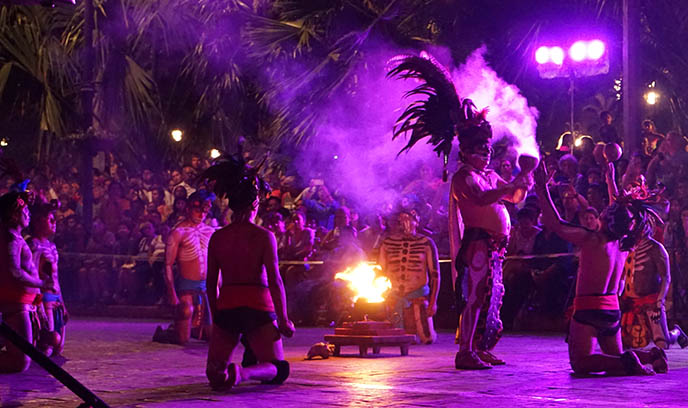
The ball players, with their faces and bodies painted like skeletons, paced and genuflected in unison. An elder in a headdress held up a smoking goblet to their outstretched arms… it was like a scene from the Apocalypto movie.

Let the games begin. To play Pok Ta Pok, the two teams try to pass the ball through a small ring in the center, without using their hands, feet or heads.
Some records indicate that in ancient times, the victorious team was honored… by being sacrificed. Or, perhaps only the winning captain was decapitated. (We didn’t stick around for the full match to find out!)

Merida’s boutiques were open late, so we did a bit of browsing and souvenir shopping. Skulls and bones, everywhere… even a cat skeleton.

Merida is known for its elaborate silver filigree jewelry, and embroidered garments (huipils). I couldn’t resist getting one of these squiggly-mouthed skeletons as a memento.

I came across a group of Nuestra Señora de la Santa Muerte, or the Lady of Death.
But I took home this Boo~ t-shirt… How could I resist the bizarre cracked-egg ghost design? (It reminds me of the shy Nintendo character as well.)
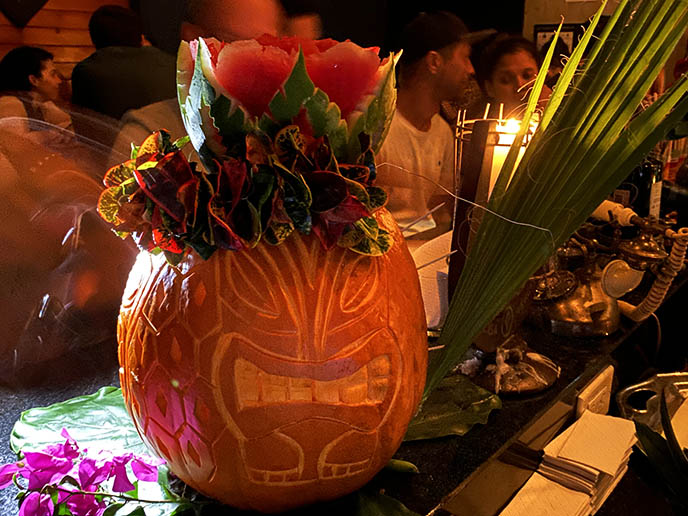
Time to wrap up with a drink at Malahat, a hidden speakeasy bar. I’m not exaggerating when I say hidden… the entrance was extremely well concealed. It took us quite a few tries before figuring out how to get inside. (Hint, look for a secret entrance in an alley-like area in the back, by the parking lot).
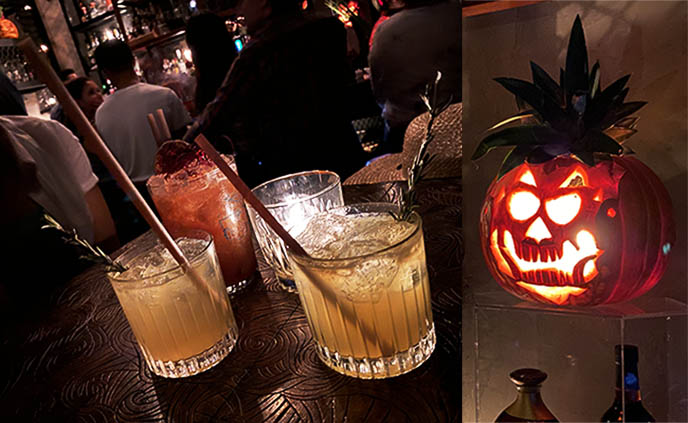
Loved the craft cocktails and hip atmosphere at Malahat. The bar carries a wide variety of liquors from Mexico and abroad. I highly recommend the “Mayahuel” cocktail, which contained green chartreuse and a spring of burning rosemary.

We enjoyed the live electronic sounds of a DJ, and admire the winning pumpkins from that evening’s Jack-o-lantern carving contest.
(For more Merida travel tips, see my first story about the Paranormal Museum, elegant mansions, and Day of the Dead cemetery parade).
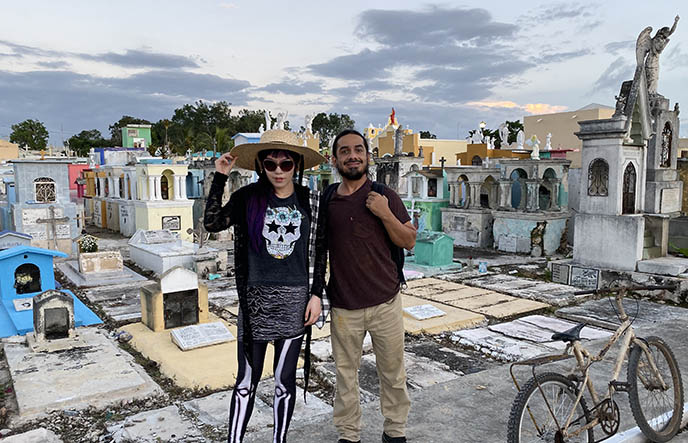
Thank you to Salvador Olguin and everyone at Borderline Projects / Morbid Anatomy for inviting me on this eye-opening journey.
Wouldn’t you like to join Borderline Projects’ 2020 Mexico tour? Each year, the dates coincide with Day of the Dead but feature a different region, so it’s never exactly the same.

You can find out more on Borderline’s website, and sign up for their newsletter. This way, you’ll be the first to know next year’s trip details and registration.
Perhaps I’ll be back as well… so we can travel together, and experience Day of the Dead in Mexico!
SHARE & COMMENT
Mexico City’s hippest boutique hotel: Mumedi design museum! Day of the Dead skulls, art exhibits, celebrations.

Hooray for Day of the Dead in Mexico City!
I couldn’t resist striking a disco pose in front of this massive neon skull that appears to be chomping down on me. (This rainbow display was the Celebrando la Eternidad at Bosque de Chapultepec.)
What a pleasure to finally visit CDMX — and during the most Gothic time of the year, when the dead have returned and every public space is filled with smiling skeletons.

As I predicted, La Ciudad de México was my type of urban destination. I got my fill of Dia de los Muertos, and uncovered vibrant pockets of alternative art and spooky culture.
Buckle up for a visual onslaught of Mexican skeletons, along with my inspiring stay at the Mumedi Mexican Museum of Design!
(Quite a few local children admired my Rocket Dog platform sandals. You can find these and more of their funky shoes below:)

I’ve stayed in a lot of artistic hotels over the years, but Mumedi’s interiors made my jaw drop. This photo speaks for itself: my room’s soaring design includes exposed brick walls, wood beams and a dramatic circular mirror.
The building is more than 400 years old, and Mumedi preserves its skeleton. However, the architects added impressive high-tech touches such as blinds that shift with the touch of a button, and a hidden ceiling fan whose wings emerge from the light!

Design Hotel Mumedi is a secret spot within the historic city center. The museum is only steps from Mexico City’s huge Zocalo square, and visitors pass through every day. Yet very few realize that there’s a hip hotel right up the stairs!
Mumedi has six rooms available for guests, and each is decorated differently. I loved the contrast between the centuries-old walls and contemporary furnishings, and whimsical touches such as a silver ducky on the bed.
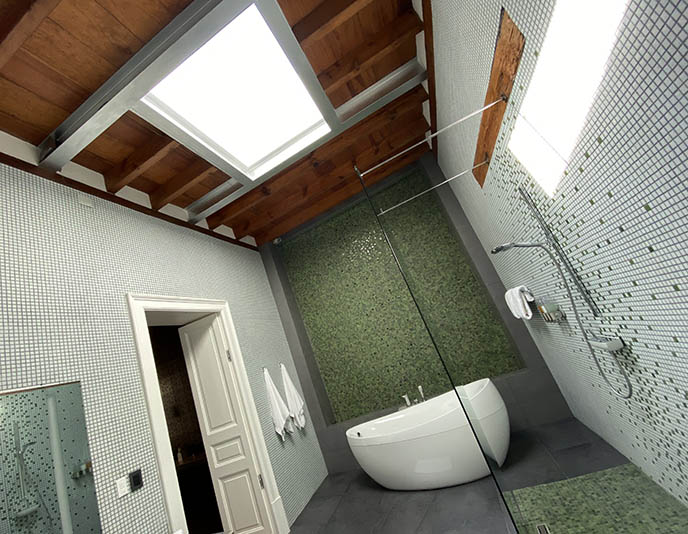
In recent decades, Mexico City has become known for its modern architecture (I’ll show you some of the coolest structures in an upcoming post).
For a design-lover like myself, Mumedi boutique hotel lets you feel as if you’re living in your fantasy home. That free-standing bathtub is goals…

Mumedi, or Museo Mexicano del Diseño, is a renown multidisciplinary space focused on design and creativity. Locals come to see the latest exhibits, and enjoy the modern cafe and restaurant (I’ll show you the delicious meals at the end of this article).
As a hotel guest, I loved having insider access to the museum. Most visitors have no clue that there’s a courtyard in the upper floors, or a row of skull posters visible only to those staying overnight.

Even if you don’t book a room here, you should pop by Mumedi for the free public displays. I was enthralled by the glass cases filled with quirky textiles, photos, typography, and other design projects.
Mumedi is especially fond of playful pop culture. They recently had a photo exhibition featuring B Duck, the cute Asian avian. (Remember when I found the massive yellow ducky floating in Hong Kong’s harbor?)

One of the coolest stores I visited in Mexico City was right here, at MumediShop. The concept store is bursting with design objects from around the world, at a variety of price points.
Acting as an incubator, MumediShop puts a strong focus on young, local handmade works — like these quirky wallets above. On the upper levels, I flipped through books about fashion, photo, art and architecture.

For a nominal fee, you can enter Mumedi’s spacious gallery to see the current exhibition (and access is free to guests staying at the hotel). I was thrilled to catch “To Death With A Smile,” a collection of posters revolving around Day of the Dead themes.

The windows displayed gorgeous jewelry by Mexican artisans. The sugar skull earrings and necklaces were exquisitely made, and very tempting…

Mumedi put out a call for entries to artists around the world, and more than 5000 submitted poster designs that riffed on the theme of death. It was eye-opening to see the wide variety of interpretations in the 300 finalists. These ranged from a pointillist skull made out of ticking clocks, to a cartoon skeleton musing “Whose day am I going to ruin?”
(I’ll share more from Mumedi at the end of this post, including a peek at their creative menu. Already, I think you can see why I chose to stay at this stylish boutique hotel!)
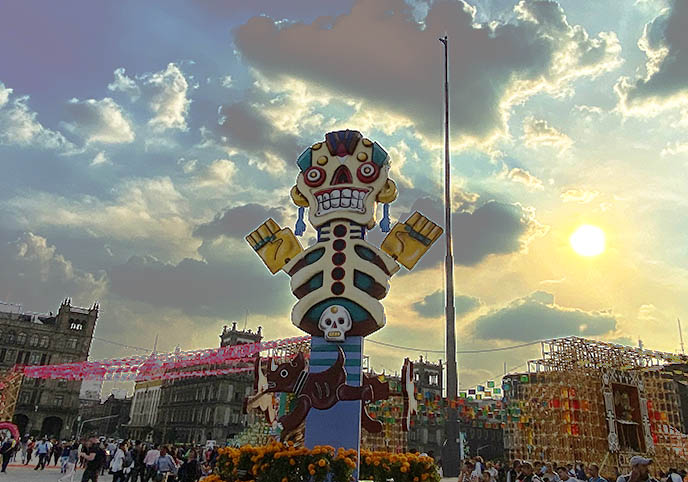
Let’s wander outside to hunt for more skulls. Mumedi is steps from the Plaza del Zócalo, the enormous main square of Mexico City. This has been an important gathering spot for residents since the days of the Aztec.
Safety note: be aware of pickpockets, and use zippered bags that you keep close to your body. There are plenty of police officers on these streets, so there’s no cause for concern — but always be aware of your surroundings, wherever you travel.
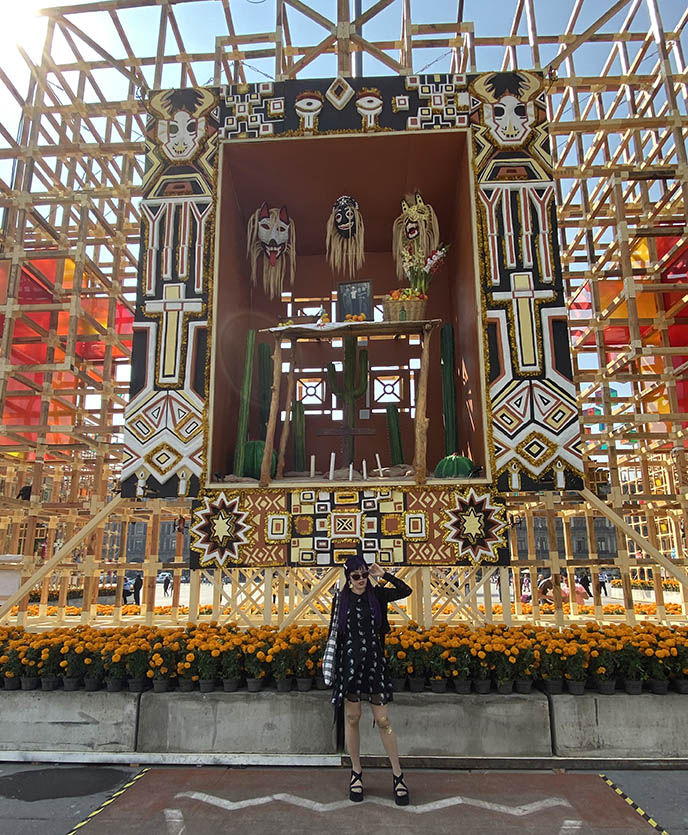
Day of the Dead has its roots in various indigenous rituals across Mexico. This current capital was once called Tenochtitlan, and ruled by the Aztec. Locals believed in Mictecacihuatl, a fearsome goddess of death and the underworld that they appeased through offerings of food and objects.
Quite fittingly, Zocalo continued to honor the dead with an “Altar of Altars” exhibition. The square was decorated with four gigantic “ofrenda,” each representing a different regional or cultural style (the Maya, the Yaqui, Huasteca, and Michoacán).
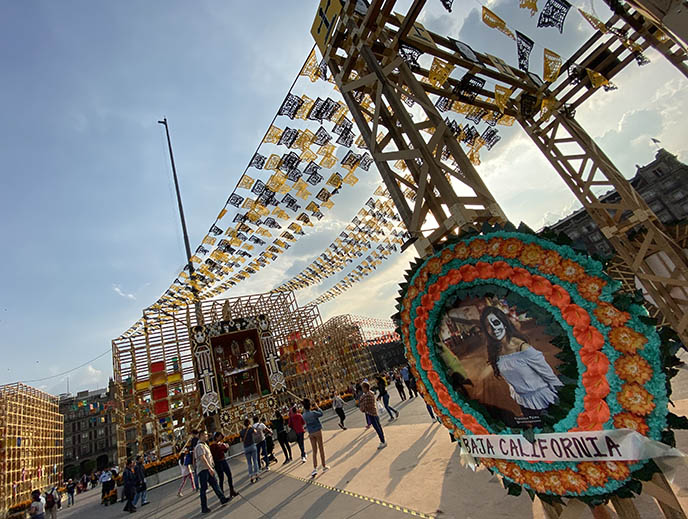
Now that I’ve experienced Dia de los Muertos in Merida with Borderline Projects, I’m keen to see how other parts of Mexico put their own spin on the sugar skull parades.

Unlike the horror of Halloween, Mexico’s Day of the Dead is a cheery and colorful occasion. The sugar skulls are painted in rainbow hues, and they’re always grinning widely.
This happy skeleton is accompanied by a bouncing undead dog much like Scraps in The Corpse Bride movie. (Appropriately for Mexico, it appears to be a chihuahua!)

The mega-altars were temporarily erected to celebrate Day of the Dead. However, at all times of the year, Mexico City’s Zocalo has public art installations or performances.
You can also walk to nearby historic sights like the National Palace, Cathedral, Palace of the Arts (Palacio de Bellas Artes), and Templo Mayor ruins, which I’ll show you in an upcoming story.
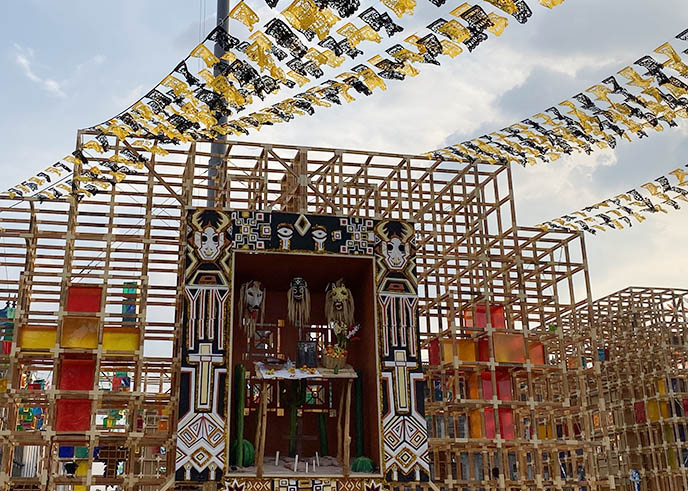
If you’re in Mexico City on November 2, you can join 800,000 people and see one of the world’s largest Day of the Dead parades. The ghostly costumes and floats will make you feel as if you’re crossed over into the realm of the dead, much like in the movie Coco.
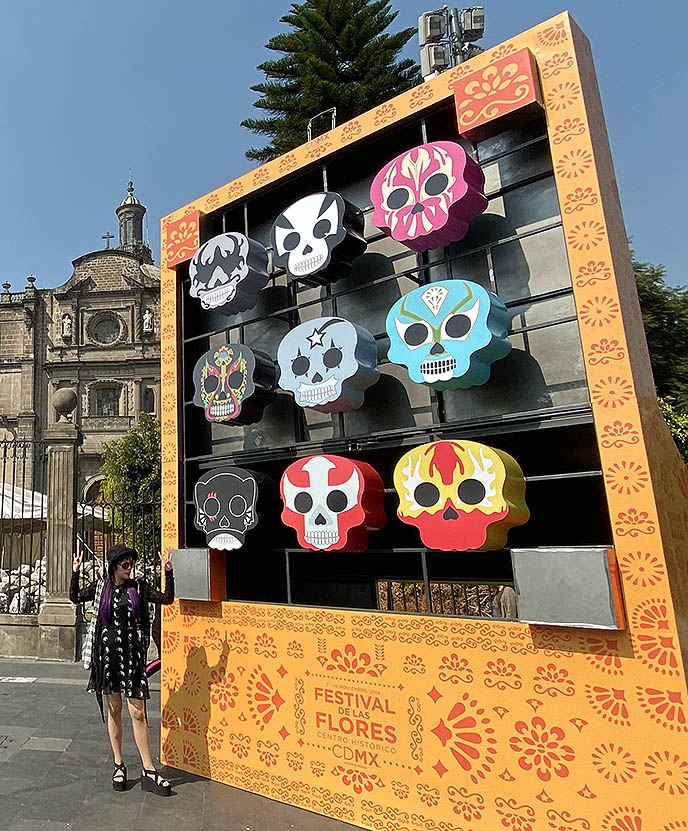
I arrived right after these celebrations, when Centro Historico was getting ready for the Festival de Las Flores. In pre-Hispanic times, locals would make floral offerings to Xiuhtecuhtli (Lord of Flowers) to encourage bountiful crops.
In front of Templo Mayor, I was tickled to see a modern version of a tzompantli. During the Aztec era, the bloody heads of sacrificial victims were mounted onto a rack like this.
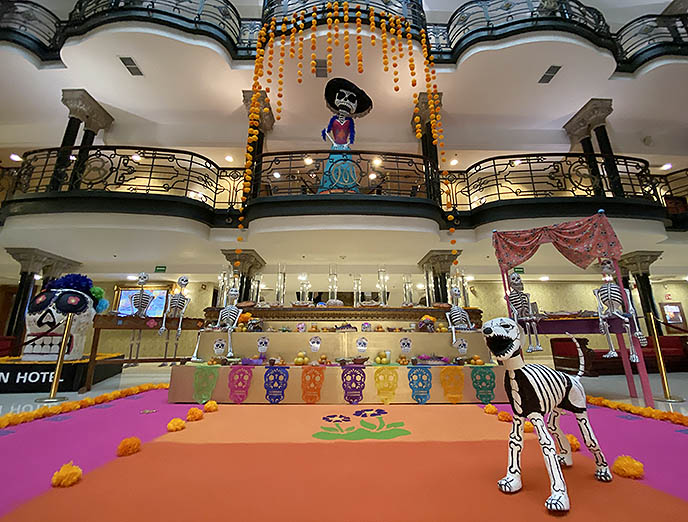
I enjoyed strolling around the historic center of Mexico City and admiring elegant buildings from past centuries. One of my favorites was the Gran Hotel Ciudad de Mexico — you’ve got to pop in to see the Art Nouveau architecture.
Look who’s peering over the balcony: La Catrina! The “elegant skeleton” was first drawn by Mexican caricaturist José Guadalupe Posada, who poked fun at the wealthy by drawing therm as vain bags of bones. Today, La Catrina Calavera is an icon of Day of the Dead.
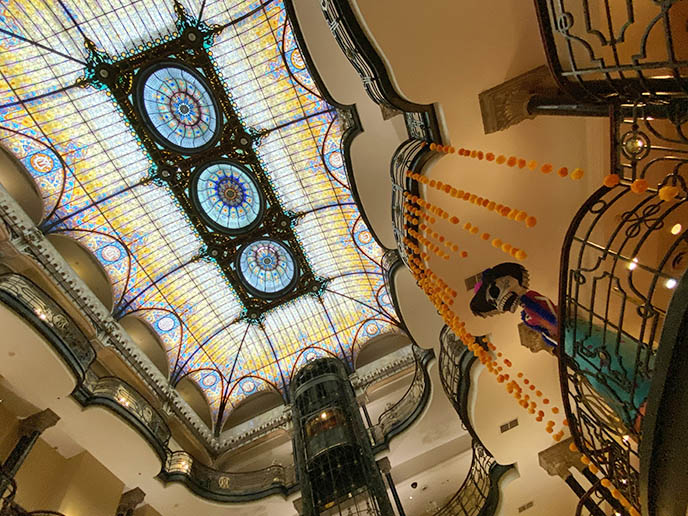
Look up and take in the beauty of the Art Nouveau design, which includes a Louis XV chandelier, wrought iron elevators, and Tiffany stained glass windows and ceilings from the workshop of Jacques Graber.

No wonder the lady skeleton in a feathered hat and gown feels at home here. The Dia de los Muertos altar in the lobby matched perfectly with the 19th century aristocrat atmosphere.

Gran Hotel Ciudad de Mexico brought out smiling paper mache skeletons to illustrate these seasonal rituals. The altar was stacked with enticing ofrenda like pan de muerto (bread of the dead, with bone shaped decor on top), tamales, sugar skulls, and orange marigold flowers.

Mexicans tend to put up photos of their ancestors, and surround them with their favorite things. While strolling around, I came across an altar honoring Bruce Lee! I wonder if they included the Hong Kong martial artist’s favorite food, beef in oyster sauce.

Then, I escaped the congestion of CDMX by taking a 30 minute Uber ride to Coyoacán, a calm borough filled with greenery and residences. Once an Aztec village known as the “place of coyotes,” this is now a peaceful historical area with plenty of parks and plazas for unwinding.
I’m wearing Bayer platform sandals by Rocketdog and a bucket hat by Lack of Color.

One of Coyoacan’s best-known attractions is the Frida Kahlo museum, aka the Blue House. The Mexican artist was born and died in her family home, which now houses some of her most important works. (There was a huge line-up for the Museo Frida Kahlo, so we decided to skip it.)

We took our time to browse Coyoacan’s many handicraft and food markets. I was drawn to these calavera de azúcar, or handmade sugar skulls decorated with vibrant colors.
These sweets represent those who have departed — small skulls for children, and larger ones for adults. During dia de los muertos, their spirits return to enjoy the offerings on the altar.

Even in pre-Columbian times, people incorporated imagery of skulls and skeletons in their art. (I’ll show you these symbols at the Anthropology Museum later on.)

Today, you can find skull-themed everything in Mexico City. Skull earrings, skeleton decor, spooky shirts… It’s a Goth shopping dream.

Perhaps you can pick up a hand-painted Catrina or sugar skull as a keepsake.

At this time of year in Mexico, you’ll feel like there is no separation between the living and dead. These skeletons look quite content as hat models.

These leather jackets with Mexican textiles, fringe and sugar skulls on the back… yes.

I found a “Feliz Navidarks” Christmas shirt from a store called Cuidado con el Perro. Couldn’t resist this funny Santa Skeleton top.
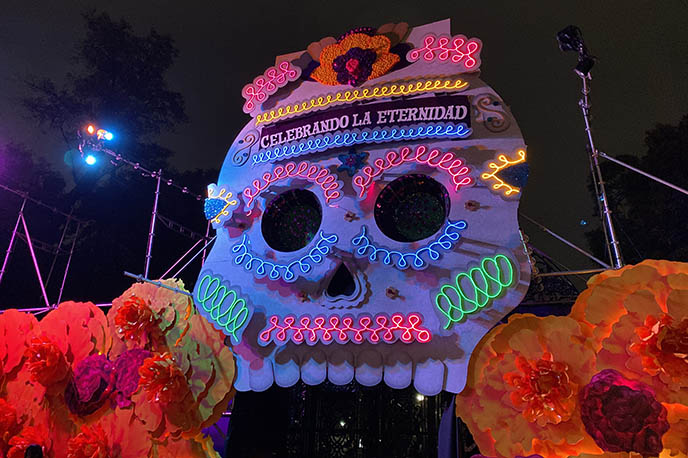
My “sugar skull hunt” culminated with the ultimate find: this towering, lit-up calavera for Celebrando La Eternidad. It guards Bosque de Chapultepec, one of city’s largest parks and an important eco space. This lush public area was once also a retreat for Aztec rulers.

In the weeks surrounding Day of the Dead, the Bosque has a number of events to celebrate eternity. These including light projections on the lake, and ancient dances by performers in skull facepaint.

I think the psychedelic skull is ready to have a disco party! His jaws are framed by humongous orange marigolds, or Cempasuchil flowers of the dead.

Every evening, I was glad to return to my home base at Mumedi. I felt re-energized at their chic restaurant, with its friendly staff and walls covered in quirky posters.

I looked forward to a leisurely breakfast every morning at Mumedi’s cafe and restaurant. You could choose from a Continental or Mexican set — I especially loved the plantain enchilada with red sauce, and chicken or egg chilaquiles with green sauce. Each platter came with fresh fruit, juice, coffee (they have almond milk), and a black bean dip with tortilla.

Mumedi serves creative lunch and dinner dishes as well, and is open late. Their “food design” is cleverly presented yet full of traditional flavor, with fresh and healthy ingredients.
Case in point: the marrow and beef tacos on blue tortillas, a green mole steak, and “avocado” pannecotta (the seed is actually made of cocoa!)

Mumedi’s To Death With a Smile exhibit is showing until January 31, and I hope you get a chance to see it. It’s fascinating how artists from all over approach death in serious, comedic, and meaningful ways. (You can check Mumedi’s calendar of events for upcoming shows.)

And don’t forget that there’s a hidden gem upstairs — Mumedi’s dreamy design hotel. If you’re traveling with a group of friends, you could book this suite with two bedrooms and a spacious lounge area.

Shout-out to the fantastic staff, who were always eager to help and left delicious baked snacks and chocolates by my pillow every night.

Gracias Mumedi for the inspiring stay — my Mexico City trip wouldn’t have been so wonderful otherwise.
Pass it along: Mumedi’s museum / shop / cafe / hotel are a must-see in CDMX. (Photos by me and Julie Hunter of Flash Fiction Kitchen.)

Have you ever seen so many skeletons in one destination? Well, there are more to come… I have Day of the Dead stories galore to share with you, from my Yucatan travels with Borderline Projects x Morbid Anatomy!
If you missed my first Dia de los Muertos post, see it here — I danced with the dead in a Merida cemetery, and encountered the supernatural…


 LA CARMINA
LA CARMINA






